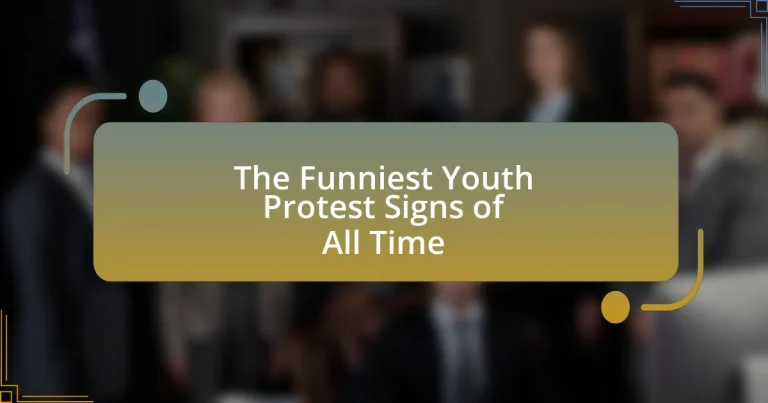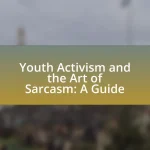The article focuses on the funniest youth protest signs of all time, highlighting their clever and humorous phrases that resonate with social issues. It explores how these signs reflect societal concerns, such as climate change and social justice, while emphasizing the role of humor and satire in engaging audiences and enhancing the message of activism. Key themes include the evolution of protest signs, the impact of social media, and best practices for creating effective signs, along with examples of iconic signs that have gained viral attention. The article also discusses the psychological effects of humor on protest participants and the importance of cultural context in interpreting humor in protest messaging.
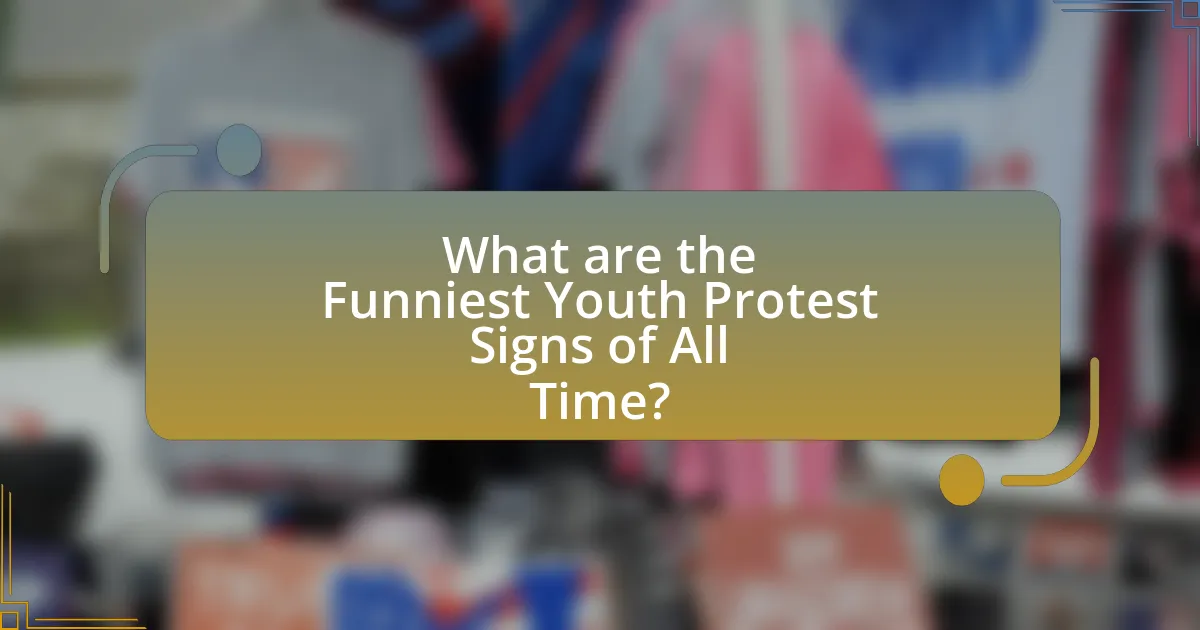
What are the Funniest Youth Protest Signs of All Time?
The funniest youth protest signs of all time include clever and humorous phrases that resonate with social issues. Examples include “I can’t believe I still have to protest this shit,” which highlights frustration with ongoing societal problems, and “Make America Grape Again,” a playful twist on political slogans that captures attention while addressing serious topics. These signs often utilize puns and satire to engage audiences, making them memorable and impactful. The humor in these signs not only entertains but also emphasizes the seriousness of the causes they represent, showcasing the creativity and wit of youth activism.
How do youth protest signs reflect societal issues?
Youth protest signs reflect societal issues by encapsulating the concerns and values of younger generations, often addressing topics such as climate change, social justice, and inequality. These signs serve as a visual representation of the collective frustrations and aspirations of youth, highlighting their desire for change and accountability from those in power. For instance, during the 2019 climate strikes, youth signs prominently featured slogans like “There is no Planet B,” which directly pointed to the urgent issue of environmental degradation and the need for sustainable policies. This direct engagement with pressing societal problems illustrates how youth utilize protest signs as a medium to voice their perspectives and demand action on critical issues affecting their futures.
What themes are commonly found in youth protest signs?
Common themes found in youth protest signs include social justice, climate action, equality, and anti-establishment sentiments. These themes reflect the concerns and values of younger generations, often addressing issues such as racial equality, environmental sustainability, and political accountability. For instance, during climate strikes, youth frequently use signs that emphasize the urgency of climate change, showcasing slogans like “There is no Planet B.” Additionally, signs advocating for equality often highlight gender rights and LGBTQ+ issues, demonstrating a commitment to inclusivity and representation. The prevalence of these themes in youth protests underscores their active engagement in societal issues and their desire for meaningful change.
How do humor and satire enhance the message of protest signs?
Humor and satire enhance the message of protest signs by making complex social issues more accessible and engaging to a wider audience. When humor is employed, it captures attention and encourages people to reflect on serious topics in a less confrontational manner. For instance, a study by the University of California found that humorous messages can increase message retention and promote sharing on social media, amplifying the reach of the protest’s core message. Additionally, satire can highlight contradictions and absurdities in societal norms or policies, prompting critical thinking and discussion among viewers. This combination of engagement and critical reflection makes humor and satire powerful tools in the effectiveness of protest signs.
Why is humor an effective tool in youth protests?
Humor is an effective tool in youth protests because it engages audiences, diffuses tension, and fosters solidarity among participants. By using humor, young activists can capture attention and convey serious messages in a relatable manner, making complex issues more accessible. For instance, studies show that humorous content can increase message retention and encourage sharing on social media platforms, amplifying the reach of protest messages. Additionally, humor can create a sense of community and resilience among protesters, as seen in various movements where comedic signs and chants have united participants against common adversities.
How does humor engage a wider audience during protests?
Humor engages a wider audience during protests by making serious issues more approachable and relatable. When protesters use humor, such as witty signs or comedic performances, they can attract attention and foster a sense of community among diverse groups. This approach can lower barriers to participation, as humor often resonates across different demographics, encouraging individuals who might otherwise feel alienated to join the cause. For instance, during the Women’s March in 2017, humorous signs like “I Can’t Believe I’m Still Protesting This Sh*t” not only conveyed strong messages but also invited laughter, creating a shared experience that united participants.
What psychological effects does humor have on protest participants?
Humor has a significant psychological effect on protest participants by enhancing group cohesion and reducing stress. When individuals engage in humorous expressions during protests, they often experience a sense of belonging and solidarity, which can strengthen their commitment to the cause. Research indicates that humor can act as a coping mechanism, alleviating anxiety and tension associated with social activism. For instance, a study published in the journal “Psychological Science” found that humor can improve mood and foster resilience among individuals facing challenging situations, such as protests. This psychological uplift can lead to increased motivation and sustained participation in activism.
What are some iconic examples of funny youth protest signs?
Some iconic examples of funny youth protest signs include “I Can’t Believe I Still Have to Protest This Sh*t,” which humorously highlights the ongoing nature of social issues, and “Make America Grape Again,” a playful twist on a political slogan that uses humor to engage youth in activism. Another notable sign is “I Am a Child of the Internet,” which reflects the digital upbringing of today’s youth while making a statement about their connectivity and awareness. These signs resonate with young audiences by combining humor with serious messages, effectively capturing attention and sparking conversations about important topics.
Which signs gained viral attention and why?
Signs that gained viral attention include those with humorous and clever slogans, often utilizing puns or pop culture references. For example, signs like “We’re all in this together, except for the billionaires” resonated widely due to their relatable critique of economic inequality. Additionally, signs featuring memes or internet culture, such as “I can’t believe I still have to protest this shit,” captured the frustration of youth, making them shareable on social media platforms. The combination of humor and social commentary in these signs not only engaged viewers but also encouraged widespread sharing, leading to their viral status.
How have specific signs influenced public perception of youth movements?
Specific signs have significantly influenced public perception of youth movements by using humor and creativity to engage broader audiences. For instance, signs that incorporate witty slogans or playful imagery can make serious issues more relatable, thereby attracting attention and fostering dialogue. A notable example is the “We’re Here, We’re Queer, Get Used to It” sign used during LGBTQ+ protests, which not only conveyed a strong message but also resonated with the public through its catchy phrasing. Research indicates that humor in protest signs can reduce defensiveness among onlookers, making them more receptive to the underlying messages of the movements. This strategic use of humor has been shown to enhance visibility and support for youth-led initiatives, ultimately shaping how these movements are perceived in society.
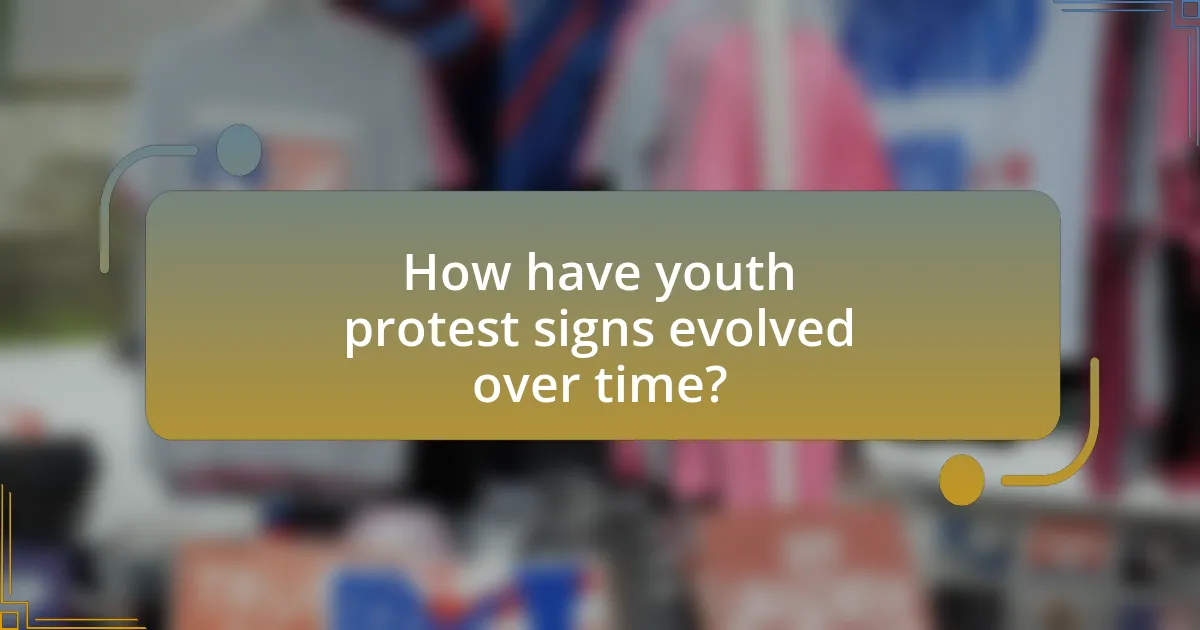
How have youth protest signs evolved over time?
Youth protest signs have evolved from simple, hand-painted messages to more sophisticated and visually engaging designs that incorporate humor and social media influences. Historically, early youth protest signs, such as those from the civil rights movement in the 1960s, featured straightforward slogans advocating for justice and equality. Over time, particularly in the 21st century, youth protest signs began to reflect a blend of humor and irony, often using memes and pop culture references to engage a broader audience. For instance, during the Women’s March in 2017, many signs featured witty phrases and playful imagery, showcasing a shift towards creativity and humor as tools for activism. This evolution highlights how youth have adapted their messaging strategies to resonate with contemporary cultural contexts and to capture attention in a crowded media landscape.
What historical events shaped the evolution of protest signs?
The evolution of protest signs has been shaped by significant historical events such as the Civil Rights Movement, the Vietnam War protests, and the Women’s Suffrage Movement. The Civil Rights Movement in the 1960s popularized the use of bold, impactful slogans on signs to convey messages of equality and justice, exemplified by the iconic “I Am a Man” signs during the Memphis sanitation workers’ strike. The Vietnam War protests in the late 1960s and early 1970s saw an increase in creative and humorous signs, reflecting public dissent against the war, with phrases like “Make Love, Not War” becoming emblematic. Additionally, the Women’s Suffrage Movement in the early 20th century utilized signs to advocate for women’s voting rights, with slogans like “Votes for Women” gaining prominence. These events collectively influenced the design, messaging, and humor found in protest signs today, demonstrating their role as a powerful tool for social change.
How did the internet and social media impact the creation of protest signs?
The internet and social media significantly transformed the creation of protest signs by enabling rapid dissemination of ideas and visual content. This shift allowed activists to share innovative designs and slogans instantly, fostering creativity and collaboration across diverse groups. For instance, platforms like Twitter and Instagram have facilitated the viral spread of humorous and impactful protest signs, such as those seen during the Women’s March in 2017, where signs like “I Can’t Believe I Still Have to Protest This Shit” gained widespread attention. This accessibility to a global audience not only amplifies the messages but also encourages a blend of humor and activism, making protest signs more engaging and relatable.
What role do memes play in modern youth protests?
Memes play a significant role in modern youth protests by serving as tools for communication, mobilization, and humor. They effectively convey complex political messages in a relatable and easily shareable format, which resonates with younger audiences. For instance, during the 2019 climate strikes, memes highlighting the urgency of climate action went viral, amplifying the movement’s reach and engagement. Research indicates that memes can increase participation in protests by creating a sense of community and shared identity among activists, as seen in movements like Black Lives Matter and the Women’s March. This combination of humor and social commentary not only attracts attention but also fosters solidarity, making memes a powerful element in contemporary youth activism.
How do cultural differences influence the humor in protest signs?
Cultural differences significantly influence the humor in protest signs by shaping the references, symbols, and language used in the messages. For instance, humor that resonates in one culture may rely on local idioms, historical events, or societal norms that are not universally understood. A study by the University of California, Berkeley, found that humor in protest signs often reflects cultural values, with Western cultures favoring irony and satire, while Eastern cultures may prefer humor that emphasizes community and harmony. This divergence illustrates how cultural context dictates the effectiveness and reception of humor in protest movements, making it essential for sign creators to consider their audience’s cultural background to maximize impact.
What are some examples of culturally specific humor in protest signs?
Culturally specific humor in protest signs often reflects local traditions, language, and societal issues. For example, during the Women’s March, signs featuring puns on local cuisine, such as “This is nacho average protest,” resonate with communities that have a strong food culture. Additionally, signs that incorporate regional dialects or slang, like “Y’all need to listen,” engage audiences by using familiar language. In LGBTQ+ pride marches, humor can be culturally specific, such as “We’re here, we’re queer, get used to it,” which plays on the cultural context of acceptance and visibility. These examples illustrate how humor in protest signs can effectively connect with specific cultural identities and experiences, making the messages more relatable and impactful.
How do language and context affect the interpretation of humor in signs?
Language and context significantly influence the interpretation of humor in signs by shaping the meaning and reception of the message. The specific choice of words, idioms, and cultural references can either enhance or obscure the humor, depending on the audience’s familiarity with the language and context. For instance, a pun or play on words may be hilarious to one demographic while completely lost on another due to linguistic differences or cultural nuances. Research indicates that humor often relies on shared knowledge and situational context; therefore, signs that resonate with a particular group can effectively convey humor, while those that lack contextual relevance may fail to elicit laughter. This dynamic illustrates how language and context are crucial in determining the effectiveness of humor in protest signs, as they must connect with the audience’s experiences and cultural background to be impactful.
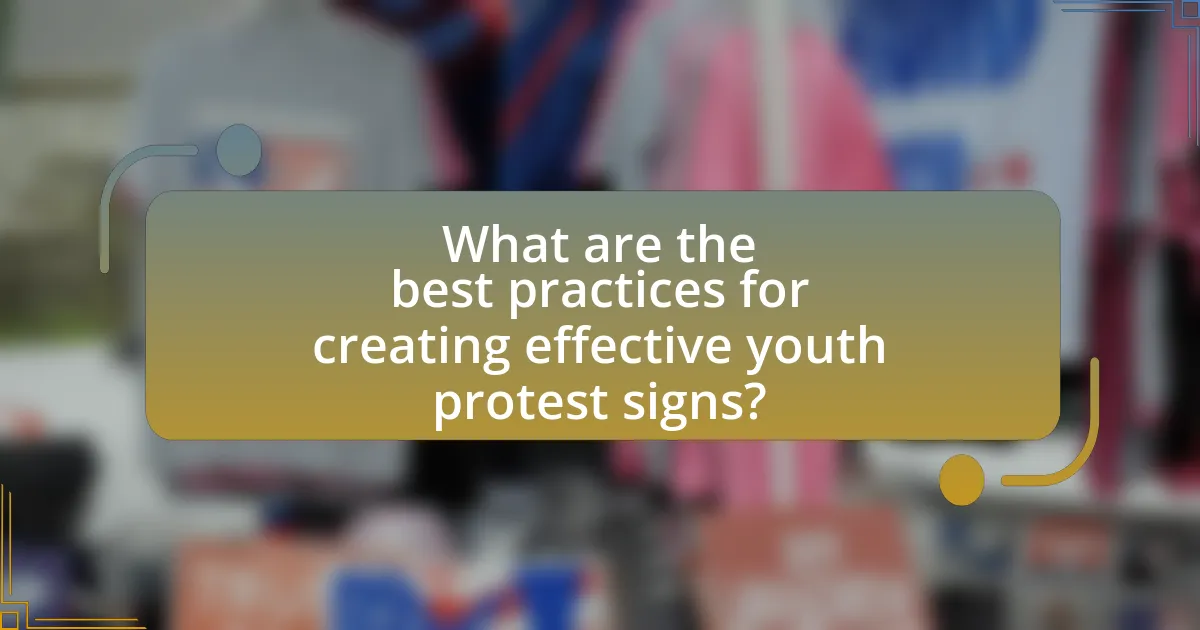
What are the best practices for creating effective youth protest signs?
Effective youth protest signs should be clear, concise, and visually engaging. Clarity ensures that the message is easily understood at a glance, while brevity allows for quick reading; for instance, using short phrases or impactful words can convey strong sentiments without overwhelming the viewer. Visual elements, such as bold colors and large fonts, enhance visibility and attract attention, making the sign stand out in a crowd.
Additionally, incorporating humor can make the message more relatable and memorable, as seen in various successful protests where witty slogans have gone viral. For example, during the Women’s March, signs with clever puns or humorous illustrations effectively communicated serious issues while engaging a broader audience.
Using symbols or imagery relevant to the cause can also strengthen the message, as visual associations often resonate more deeply with viewers. Overall, these best practices contribute to the effectiveness of youth protest signs by ensuring they are impactful and memorable.
How can humor be effectively incorporated into protest signs?
Humor can be effectively incorporated into protest signs by using clever wordplay, puns, and visual humor that resonate with the audience. Clever phrases or jokes can simplify complex issues, making them more relatable and memorable, which enhances engagement. For instance, during the Women’s March, signs like “I Can’t Believe I Still Have to Protest This Sh*t” combined humor with a serious message, capturing attention and sparking conversation. Research shows that humor can increase message retention and encourage sharing on social media, amplifying the protest’s reach and impact.
What tips can help ensure clarity and impact in protest messaging?
To ensure clarity and impact in protest messaging, use concise language and strong visuals. Concise language allows the message to be easily understood at a glance, while strong visuals, such as bold graphics or images, capture attention and reinforce the message. Research indicates that messages with clear visuals are 65% more likely to be remembered compared to text-only messages. Additionally, using relatable humor can enhance engagement, as seen in youth protests where funny signs often go viral, increasing the reach and impact of the protest.
How can visuals enhance the humor in protest signs?
Visuals enhance the humor in protest signs by using imagery that amplifies the message and evokes laughter. For instance, clever illustrations or exaggerated caricatures can create a stark contrast with serious issues, making the signs memorable and engaging. Research indicates that humor in visual communication can increase retention and understanding, as seen in studies on visual rhetoric, which show that humorous visuals can lead to greater audience engagement and emotional response. This combination of humor and visual elements effectively captures attention and fosters a sense of community among protesters.
What common mistakes should be avoided when making protest signs?
Common mistakes to avoid when making protest signs include using overly complex language, which can confuse the message, and failing to ensure visibility, as signs need to be easily read from a distance. Additionally, using too many colors or cluttered designs can detract from the main message, making it less impactful. Research indicates that clear and concise messaging significantly increases the effectiveness of protest signs, as demonstrated in studies on communication strategies in social movements.
How can overly complex messages dilute the effectiveness of a sign?
Overly complex messages dilute the effectiveness of a sign by making it difficult for viewers to quickly understand the intended message. Signs are often viewed in fast-paced environments, such as protests, where clarity is crucial for immediate comprehension. Research indicates that cognitive load increases with complexity, leading to decreased retention and understanding of the message. For instance, a study published in the Journal of Experimental Psychology found that simpler messages are processed more efficiently, resulting in higher recall rates. Therefore, when signs contain convoluted language or intricate ideas, they fail to communicate effectively, reducing their impact in conveying the protest’s purpose.
What are the risks of using humor that may offend or alienate audiences?
Using humor that may offend or alienate audiences can lead to significant backlash, including loss of credibility and audience engagement. When humor targets sensitive subjects or marginalized groups, it risks reinforcing stereotypes and perpetuating discrimination, which can alienate those affected. Research indicates that 70% of individuals may disengage from content that they find offensive, leading to diminished reach and impact. Additionally, offending humor can provoke negative reactions on social media, resulting in public relations crises that damage reputations. Therefore, the risks associated with potentially offensive humor are substantial and can undermine the intended message of unity and protest.
What resources are available for youth creating protest signs?
Youth creating protest signs can access various resources, including online platforms, community workshops, and educational materials. Websites like Canva and Adobe Spark offer templates and design tools specifically for creating impactful signs. Local community centers and schools often host workshops that teach sign-making techniques and provide materials. Additionally, social media platforms serve as a source of inspiration, showcasing examples of effective protest signs. These resources empower youth to express their messages creatively and effectively, contributing to the broader dialogue on social issues.
Where can youth find inspiration for their protest signs?
Youth can find inspiration for their protest signs in social media platforms, art and literature, and historical movements. Social media, particularly Instagram and Twitter, showcases a variety of creative and humorous signs from past protests, allowing youth to see what resonates with their peers. Additionally, art and literature often contain powerful quotes and imagery that can be adapted into sign designs. Historical movements provide context and examples of impactful messaging, which can inspire youth to craft their own unique statements. For instance, the Women’s March and climate strikes have generated a wealth of innovative sign ideas that can be referenced for inspiration.
What tools and materials are recommended for sign-making?
Recommended tools and materials for sign-making include poster boards, markers, paint, stencils, and adhesive materials like glue or tape. Poster boards provide a sturdy base for signs, while markers and paint allow for vibrant colors and clear messaging. Stencils can help create uniform letters and designs, ensuring readability. Adhesive materials are essential for attaching additional elements or reinforcing the sign’s structure. These tools and materials are commonly used in various sign-making contexts, including protests, to effectively convey messages.
